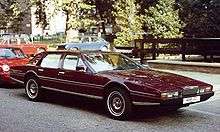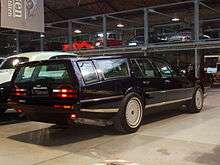Aston Martin Lagonda
The Aston Martin Lagonda is a full-size luxury four-door saloon which was manufactured by British automobile manufacturer Aston Martin between 1974 and 1990. A total of 645 were produced. The name was derived from the Lagonda marque that Aston Martin had purchased in 1947. There are two distinct generations, the original, the short lived 1974 design based on a lengthened Aston Martin V8, and the entirely redesigned, wedge-shaped Series 2 model introduced in 1976 along with subsequent evolutions.
| Aston Martin Lagonda | |
|---|---|
| Overview | |
| Manufacturer | Aston Martin |
| Production | 1976–1990 |
| Designer | William Towns |
| Body and chassis | |
| Class | Full-size luxury car (F) |
| Body style | 4-door saloon |
| Layout | Front-engine, rear-wheel-drive |
| Powertrain | |
| Engine | 5.3 L (5,340 cc) V8 |
| Chronology | |
| Predecessor | Lagonda Rapide |
| Successor | Lagonda Taraf |
In 2014, Aston Martin confirmed it would launch a new Lagonda model called the Taraf for the Middle-East market, sold on an invitation only basis which is considered to be the successor of the Lagonda saloon.[1]
History
Aston Martin was facing financial pressure in the mid-1970s and needed something to bring in some much-needed funds. Traditionally, Aston Martin had worked on 2+2 sports cars, but the Lagonda was a four-door saloon. As soon as it was introduced, it drew in hundreds of deposits from potential customers, helping Aston Martin's cash reserves.[2]

After the production of seven Series 1 cars, the Lagonda was designed from the ground up in 1976 by William Towns as an extreme interpretation of the classic 1970s "folded paper" style. It was an unconventional design practice for Aston Martin and still is. Together with famous contemporaries like the Lamborghini Countach, Lotus Esprit, and the DMC DeLorean, the Lagonda is frequently named among the most striking wedge-shaped designs of all.[3][4][5] Car enthusiasts are fiercely divided on the car's aesthetic value. The Lagonda combined striking styling with premium leather interior, and advanced instrumentation for its time. Coupled to a Chrysler three-speed "TorqueFlite" automatic transmission its four-cam carbureted V8 provided poor, often single-digit, fuel economy, little improved by the change to fuel-injection in the Series 3.
Throughout the history of the marque, the hand-built Lagonda was amongst the most expensive luxury saloons in the world. The only other production cars to approach its price tag were the Rolls-Royce Silver Spirit/Silver Spur and the Bentley Mulsanne.
The Lagonda was the first production car to use a digital instrument panel.[6] The development cost for the electronics alone on the Lagonda came to four times as much as the budget for the whole car. The Series 3 used cathode ray tubes for the instrumentation, which proved even less reliable than the original model's light-emitting diode (LED) display.
It was named by Bloomberg Businessweek as one of the 50 ugliest cars of the last 50 years[7] and Time Magazine included it in its "50 Worst Cars of All Time", describing it as a mechanical "catastrophe" with electronics that would be impressive if they ever worked.[8]
Models
A number of iterations of the Lagonda were produced during its production lifespan. Those iterations are called "Series" cars and include the original Series 1, and the wedge shaped Series 2, 3 and 4. A total of 645 cars were produced in the 12-year production run of the wedged shaped version.
Series 1 (1974–1975)
A long-wheelbase, four-door version of the Aston Martin V8 was announced at the 1974 London Motor Show. Designed by William Towns and based on the DBS, it was the first car to wear the Lagonda name since the 1961 Rapide.[9] The 5.3 L V8 engine was supplied with either a 5-speed manual or automatic transmission.[10] In appearance, the car is essentially a 4-door version of the Aston Martin V8. Only seven were sold.[11]
Specifications (Series 1)
- Engine and power output: 5.3 L 5,340 cc (326 cu in) DOHC V8, 280 hp (209 kW; 284 PS) 301 lb⋅ft (408 N⋅m) of torque
- Top speed: 240 km/h (149 mph)
- 0–97 km/h (0–60 mph): 6.2 seconds
- Length: 4,928 mm (194.0 in)
- Wheelbase: 2,910 mm (114.6 in)
- Width: 1,829 mm (72.0 in)
- Height: 1,323 mm (52.1 in)
- Weight: 2,000 kg (4,409 lb)
At least 2 of the cars having chassis numbers 12003[11] and 12005,[12] have been upgraded by R.S. Williams, Ltd of Cobham to a 7.0 litre version of the original Aston Martin V8 engine, able to generate a power output ranging from 440 to 480 hp (328 to 358 kW) to[11] on unleaded fuel.
Series 2 (1976–1985)
.jpg)

The wedge shaped Lagonda V8 saloon was launched in 1976 at the London Motor Show and was a total contrast to the 1974 model, sharing little but the engine.[13] Deliveries of the Lagonda did not commence until 1979. Series 2 cars were originally fitted with digital LED dashboards and touch pad controls, but the innovative steering wheel controls and gas plasma display were abandoned in 1980. The Lagonda retailed at GB£49,933 in 1980, significantly more than a Ferrari 400 or Maserati Kyalami but less than a Rolls-Royce Corniche.[14] The car commenced sales in the US from 1982 with minor amendments to the front bumper and airdam due to regulations.[15]
Specifications (Series 2)
- Engine and power output: 5.3 L 5,340 cc (326 cu in) DOHC V8, 280 hp (209 kW; 284 PS) at 5,000 rpm 302 lb⋅ft (409 N⋅m) of torque at 3,000 rpm
- Top speed: 230 km/h (143 mph)
- 0–97 km/h (0–60 mph): 8.8 seconds[16]
- Length: 5,281 mm (207.9 in)
- Wheelbase: 2,916 mm (114.8 in)
- Width: 1,791 mm (70.5 in)
- Height: 1,302 mm (51.3 in)
- Weight: 2,023 kg (4,460 lb)
Series 3 (1986–1987)

The Series 3 was produced for only one year with 75 units manufactured, and featured fuel injected engines. Originally with cathode ray tube instruments, later versions featured a vacuum fluorescent display system similar to that used by some Vauxhalls and Opels, but were the same as the Series 2 model from the exterior.
Series 4 (1987–1990)
The Series 4 was launched at the Geneva Motor Show in March 1987 and received a significant exterior facelift by the car's original designer William Towns. The car's sharp edges were rounded off and the pop-up headlights were eliminated, with a new arrangement of triple headlights on each side of the grille being the most obvious alteration, along with the removal of the side swage line (or character line) and the introduction of 16-inch wheels. With production of around one car per week, 105 Series 4 cars were manufactured. The last car was produced during January 1990.[17]
81 remain registered in the United Kingdom as of 2011, down only slightly from 94 in 1994, but 32 of the surviving examples are SORN.[18]
Special variants

Aftermarket variations of the Lagonda included:
- Tickford Lagonda (1983) – Five Series 2 Lagondas were sold with a bodykit and upgraded interiors.[19]
- Tickford limousine (1984) – Four long-wheelbase Lagondas were made, at a cost of GB£110,000 each. On these cars, the rear door window glass was split vertically in half.
- Rapide (a two-door, short-wheelbase version) – One made, and shared the front triple light design of the Series 4.
- Shooting-brake (Estate), by Swiss company Roos Engineering – One made in 1998 using a 1987 model[20][21][22]
References
- Walker, Steve (25 July 2014). "Lagonda is back! Aston Martin teases new super-saloon". Auto Express. Retrieved 16 June 2015.
- Chapman, Giles (2009). Illustrated Encyclopedia of Extraordinary Automobiles. DK Publishing. p. 286. ISBN 978-0-7566-4980-7. Retrieved 2 July 2011.
- Wedge of Tomorrow: 20 of the Greatest Sports Cars of the '70s and '80s
- The Thin End of the Wedge – RAC Cars
- 20 Radical Wedge-Shaped Cars – Best Wedge Shaped Vehicles – Road and Track
- Dowsey, David (2010). Aston Martin: Power, Beauty and Soul. Antique Collector's Club. p. 58. ISBN 978-1-86470-424-2. Retrieved 2 July 2011.
- "Fifty Ugliest Cars of the Past 50 Years: Aston Martin Lagonda – BusinessWeek". businessweek.com. Retrieved 4 June 2011.
- Neil, Dan (7 September 2007). "The 50 Worst Cars of All Time: 28 of 51, 1975–1989. 1976 Aston Martin Lagonda". Time.com.
- "Octane classic car specs". Classicandperformancecar.com. Archived from the original on 8 July 2011. Retrieved 4 June 2011.
- Autocar Motor Show Supplement 19 October 1974
- Bonhams. "1974 Aston Martin Lagonda Series I". Supercars.net. Retrieved 2 February 2020.
- Cottingham, Tim. "V8 Lagonda Series I". astonmartins.com. Retrieved 3 February 2015.
- Motor 22 October 1977
- Autocar 18 October 1980
- "Aston Martin Heritage". Astonmartin.com. Archived from the original on 24 January 2010.
- "Octane classic car specs". Classicandperformancecar.com. Archived from the original on 8 July 2011. Retrieved 4 June 2011.
- "Aston Martin Lagonda (Series 4) (1987–1990)". astonmartins.com. 9 July 2008. Archived from the original on 21 November 2008. Retrieved 2 July 2011.
- "Combined stats (2 models) Aston Martin Lagonda – How Many Left?". Howmanyleft.co.uk. Archived from the original on 28 March 2012. Retrieved 7 April 2013.
- "Astonmartins.com". Astonmartins.com. Archived from the original on 7 July 2011. Retrieved 4 June 2011.
- "Estate of Grace" (PDF). Octane. roosengineering.ch. July 2006. Archived from the original (PDF) on 7 July 2011. Retrieved 2 July 2011.
- "Roos Engineering archive". Roosengineering.ch. Archived from the original on 7 July 2011. Retrieved 4 June 2011.
- "Fahrzeugbezeichnung – Lagonda V8 Shooting Brake" (PDF). Roos Engineering (Press release) (in German). Winter 2000. Archived from the original (PDF) on 30 October 2012. Retrieved 13 May 2016.